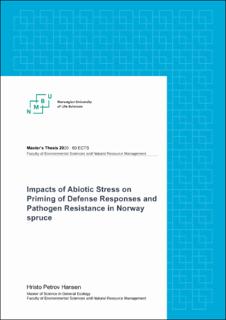| dc.description.abstract | Norway spruce (Picea abies) is one of the most important tree species in Norway due to its high economic and ecological significance in forests. Pathogens, fungi and insects may have detrimental impacts on Norway spruce trees and cause economic losses for the timber industry. Insects such as the European spruce bark beetle (Ips typographus) carry fungi and help them enter the trees as the fungi cannot penetrate the bark alone. Grosmannia penicillata is a bluestain fungus that causes discoloration and necrosis in Norway spruce trees. Together this mutualistic pair may overcome the defenses of healthy trees and kill thousands of trees during outbreaks. There have been several studies experimenting with either methyl jasmonate (MeJA) or drought against pathogens, fungi and insects, but few have studied the combined effects of drought and MeJA on Norway spruce. This study will look at the effects of MeJA, a natural defense-inducing compound found in trees, and whether Norway spruce seedlings sprayed with MeJA are more resistant to G. penicillata infection than uninfected control seedlings. Drought is also going to be a main part in this study, as drought is known to act as a priming agent in trees which enables them to respond to threats faster but may also stress trees to the point where they become more vulnerable to pathogens, fungi and insects. In this study 144 seedlings, 72 of these were sprayed with MeJA, while the other 72 seedlings were treated with Tween as a control. Half the seedlings in each treatment group were exposed to drought while the other half received ample water. The results of this study showed that the aboveground growth of Norway spruce seedlings, such as height and stem growth, were not significantly different in control and MeJA-treated plants exposed to drought. However, belowground root biomass in Norway spruce was negatively affected by the combination of MeJA application and drought exposure. The necrotic lesions caused by G. penicillata infection were significantly longer in control plants, than MeJA-treated plants. Our study shows that the combination of mild drought and minimal amount of MeJA increases Norway spruce resistance to fungi, but further studies should be done to better understand the effects of combinations of stresses on spruce defense. | en_US |

